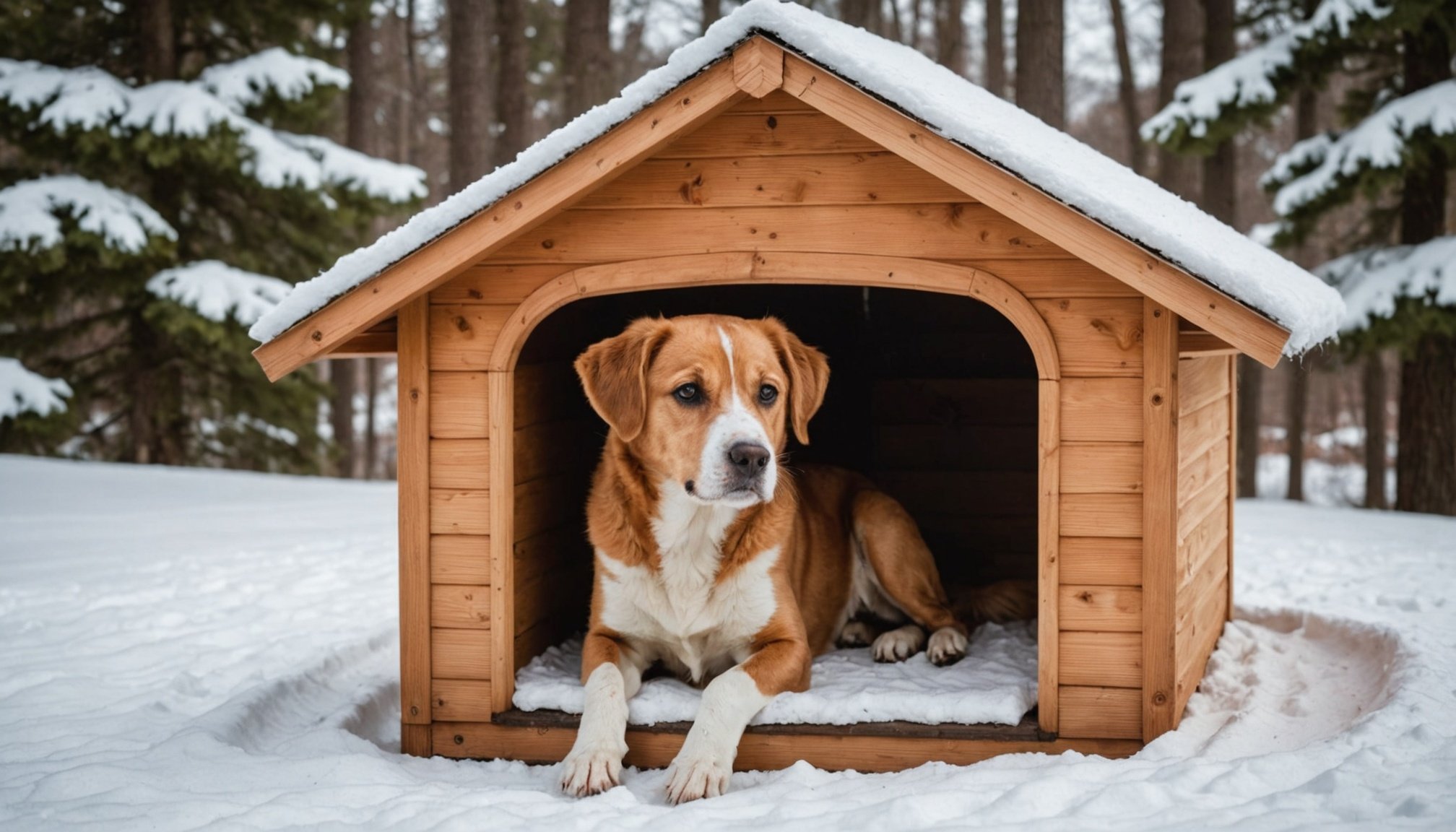Importance of Winterizing a Dog House
Winterizing a dog house is crucial for ensuring dog comfort in winter, especially as temperatures drop. Dogs, like humans, are susceptible to the biting cold, which can lead to significant health issues. Exposure to extreme cold can result in hypothermia, frostbite, and respiratory problems, making cold weather dog care essential.
Small and short-haired breeds are particularly vulnerable due to their lack of natural insulation. For these breeds, winter-proofing becomes a necessity rather than a luxury. A well-insulated dog house can serve as a vital shield against the cold, helping maintain a safe body temperature.
Also to see : Unlocking competitive agility: the ultimate training playbook for your border collie’s success
A common misconception is that all dogs can withstand cold temperatures due to their fur. These beliefs can lead to overlooking the importance of winterizing a dog house. While some breeds are more cold-tolerant, no dog is immune to the harmful effects of freezing weather over prolonged periods.
Ensuring your dog’s house is adequately winter-proofed will make a significant difference in their safety and comfort. By taking the necessary precautions, pet owners can provide a warm and protective shelter, allowing dogs to thrive despite harsh winter conditions.
Also to see : Essential guide to safely trimming your anxious guinea pig”s claws: expert advice you can trust
Insulation Techniques for Dog Houses
To ensure dog comfort in winter, choosing effective insulating materials is crucial. Foam boards are a popular choice due to their excellent thermal resistance, keeping your dog’s shelter warm. Straw is another great option as it provides natural insulation and is cost-effective. Both materials can be used effectively to line the walls, floors, and ceilings of the dog house.
Proper insulation involves careful installation to prevent gaps where cold air could enter. Focus on covering large surface areas and sealing potential drafts around doors and windows. Energy-efficient dog housing requires particular attention to these details. For added warmth, consider placing insulating materials beneath a removable interior wall lining, making it easier to manage seasonal changes.
Additionally, regular checks for signs of wear or moisture in these materials will help maintain their effectiveness. By combining quality materials and careful installation techniques, pet owners can create an environment that keeps their dog comfortable and cozy throughout the winter months.
Upgrading Dog House Structure
Enhancing the dog house design is pivotal to creating an optimal winter-proof structure. Selecting durable materials for dog houses ensures longevity and protection against harsh elements. Materials such as treated wood or weather-resistant plastic can withstand winter’s rigours, providing a robust defence against the cold.
Design improvements for winter-proof dog housing include raising the structure above the ground. An elevated dog house design prevents snow and moisture accumulation, which can lead to cold and damp interiors. Elevation not only offers increased warmth but also protects the dog house from rot and damage caused by prolonged exposure to moisture.
Incorporating a sloped roof in the design is equally important. The importance of a sloped roof lies in its ability to facilitate snow melt and efficient water drainage. This feature prevents water pooling, reducing the risk of leaks and ensuring a dry, comfortable environment for your pet. By focusing on these upgrades, dog owners can enhance their pet’s comfort and safety during the winter months.
Heating Options for Dog Houses
Providing suitable dog house heating solutions is essential for maintaining your pet’s warmth during winter. Options like heated pads and thermal blankets offer safe and effective ways to elevate the temperature inside a dog house. Heated pads, in particular, can ensure consistent warmth, while thermal blankets add an extra layer of insulation without dramatically raising the cost of energy.
When considering pet-safe heaters, it’s important to prioritize safety features like thermostatic controls and automatic shut-offs to prevent overheating. These devices provide controlled heating for pets, ensuring that their environment remains at a comfortable temperature. Always place heating devices out of reach and securely to minimize any risk of accidental burns.
Opt for energy-efficient heating solutions that focus on maintaining a balanced temperature without causing a spike in energy consumption. This approach not only ensures the well-being of your pet but also keeps operational costs low. Select products designed specifically for outdoor use, with waterproof and chew-resistant features, to withstand the elements and your pet’s natural behaviour. By choosing pet-safe and energy-conscious heating options, dog owners can create a cozy retreat that keeps their furry friends comfortable and safe throughout the chilly season.
Maintenance Tips for Winter-Proofing
Regular dog house maintenance is vital for ensuring your pet’s comfort throughout harsh winter conditions. Before the cold season commences, conduct thorough checks for wear and tear. Inspect the structure for cracks or damages that could let in drafts or cold air, and repair any issues promptly.
It’s essential to incorporate seasonal dog house care routines. Regular cleaning is crucial, not only for hygiene but also for inspecting for mold or pests that might compromise the house’s integrity and your dog’s health. Moisture control within the dog house is paramount to prevent mold growth and ensure dry, habitable conditions.
Maintaining insulation and heating systems is key to preserving warmth. Check that insulating materials like foam boards or straw remain dry and intact, replacing any compromised sections. For houses with heating systems, ensure that all devices are functioning correctly and are placed securely. Regularly verify that thermostatic controls are operating effectively to provide controlled heating for pets. By staying vigilant with maintenance, pet owners can significantly extend the dog house’s durability and functionality throughout the winter.
Hazards of Extreme Cold for Dogs
Understanding the cold weather hazards for dogs is vital to ensure their safety during winter. Dogs exposed to frigid temperatures may incur several health issues, including hypothermia and frostbite. Hypothermia, a potentially life-threatening condition, arises when a dog’s body temperature drops significantly, leading to lethargy and slowed breathing. Meanwhile, frostbite targets the ears, tail, and paws, causing skin damage that might not be immediately apparent.
Recognizing signs of cold stress in pets is crucial for timely interventions. Dogs shivering, appearing weak, or showing increased anxiety indicate they’re too cold. Promptly using warming methods can prevent health deterioration. Moreover, ensuring dog safety in winter involves creating a warm environment both inside and outside the dog house. Windbreaks, for instance, serve as effective barricades against the biting wind, reducing exposure risks.
Outside, make sure pathways are clear of ice to prevent slips and falls. Pet-friendly de-icers can prevent paw injuries. Winterizing strategies, therefore, must combine indoor and outdoor measures for comprehensive protection, keeping our furry companions safe when temperatures plummet.
Checklists and Resources for Winter-Proofing
Prepare your pet for winter with a detailed dog winter preparedness plan. Start with a winter safety checklist for pets to ensure comprehensive coverage of your dog’s needs in cold weather. This checklist includes inspecting and upgrading the dog’s shelter, choosing the right insulating materials, and ensuring effective dog house heating solutions.
Refer to dog owner resources for guidance on winterizing techniques and safety tips. Many communities offer workshops and resource hubs that can equip you with the skills needed to maintain your pet’s comfort and safety. Reach out to local pet shelters or veterinarians for community resources and support systems that focus on pet safety during winter months.
Consider resources that go beyond physical preparedness, such as guidance on nutrition and health checks essential for withstanding cold temperatures. Leverage online platforms for vet advice and forums for pet owner discussions. By combining these resources and a robust checklist, you will equip yourself to keep your dog safe and snug when temperatures drop.

